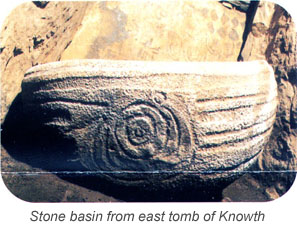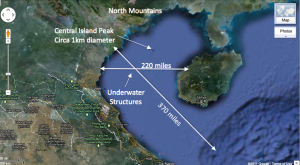Sacsayhuamán
Cunningham, Derek
Derek Cunningham is the author of a website(a) with an extensive amount of material devoted to archaeoastronomy. His core idea is that there existed in ancient times a World Map based on the the Cygnus constellation, echoing some of Andrew Collins’ work[075].
Included on his site is an article that somehow links a painting, allegedly a map, in the Lascaux Cave with a location in Viet Nam’s Gulf of Tonkin, which Cunningham describes as having “dimensions and geographical features similar to Plato’s description of Atlantis.” He later adds that “of all the various locations proposed, this is the only site that appears consistent with Plato’s description.” As a layman I found the article and the site in general, totally confusing, forcing me to lie down in a darkened room.
However, I cannot deny that Cunningham has put a lot of work into his site and he does have fans(b), but his ideas are too ‘way out’ for me.
His most recent ‘discoveries’(c) include an association of the layout of the Stonehenge complex with the Milky Way!
Cunningham has published his theories in two books, Khyung The Stone Age Astronaut[954] and 400,000 Years of Stone Age Science[955].
He later extended his studies to the remarkable terraced walls of Sacsayhuamán near Cuzco in Peru. In a 2014 illustrated article in Popular Archaeology online magazine, he claimed that the angles of the adjoining ends or sides of the irregular yet tightly fitting stones have astronomical significance!
Cunningham, has now turned his attention to angles inscribed at ancient sites, which he now claims can be associated with astronomical features and events. His extensive article(e) on the Migration and Diffusion website deals with a great many numbers that I shall leave others to evaluate.
(a) See: https://www.midnightsciencejournal.com
(b) https://thothistheibis.wordpress.com/tag/brodgar-complex/
(c) See: https://atlantipedia.ie/samples/archive-3055/
(e) https://www.migration-diffusion.info/article.php?year=2016&id=486
Erlingsson, Dr Ulf *
Dr Ulf Erlingsson is a Swedish geographer, geomorphologist and expert in underwater mapping. To explain several puzzles regarding the Ice Age, he developed The Captured Ice Shelf Hypothesis. He was the chairman of the Geographic Society of  Uppsala, Sweden and in 1991 he received the Linnaeus Prize from the Royal Society of Sciences in Uppsala.
Uppsala, Sweden and in 1991 he received the Linnaeus Prize from the Royal Society of Sciences in Uppsala.
Erlingsson was the American representative of AB Hydro consult(a), a spin-off from Uppsala University, Department of Physical Geography. A few years after moving to the U.S., he left AB Hydroconsult and founded Lindorm, Inc. in 2006, where he remains as CEO and President.
During the 1990s while studying the geography of the Baltic region, Erlingsson obtained a set of Soviet maps, which greatly assisted the building of the database he was engaged in. However, these maps, which had been bought openly in Riga, outlined plans for a Russian invasion of Sweden in the event of a war in Europe with NATO(b).
Since moving to Florida, Erlingsson has been very involved politically with the ‘Progressive’ wing of the Democratic Party.
Erlingsson recently identified the empire of Atlantis with the megalithic cultures of Western Europe and North Africa and suggested its capital may have been located in Ireland. His book [319] is interesting and contains a number of original ideas. However, as an Irishman, I am not convinced that our remarkable monuments in the Boyne Valley are the remains of or related to Atlantis. I will discuss this further in my review of his book. Erlingsson sees Atlantis everywhere, for example, in a carving on a stone basin found in the Knowth passage tomb close to Newgrange.
Erlingsson presented his ideas to the Atlantis Conference held on Milos in 2005(g).
Erlingsson has also suggested that the Irish authorities have deliberately made Newgrange inaccessible. This is total nonsense. As a frequent visitor to the site over many years, I have witnessed nothing but every effort being made to maximise the throughput of visitors into the very confined space within our most famous national monument. The carved basin (see image) discovered near Newgrange, is perceived by Erlingsson as a replica of Plato’s  circular city of Atlantis while I can see an early version of a Babylonian winged disk. In 2005, probably as a promotional ploy, he issued a challenge for an open debate on his theory.
circular city of Atlantis while I can see an early version of a Babylonian winged disk. In 2005, probably as a promotional ploy, he issued a challenge for an open debate on his theory.
Frank Joseph has related speculative ideas claiming that “the early date for New Grange, its circular construction, sophisticated solar orientation and mythic tradition all point to Atlantean origins.”[0636.70]
Like all ancient monuments, the Boyne Valley cluster has generated its own collection of wild speculation, such as Freddy Silva’s claim that there is a connection between Knowth and Sacsayhuaman near Cuzco in Peru and who also hints at a possible link with Egypt’s Osirion(f)!
Erlingsson has more recently suggested that the ‘sunken’ island referred to by Plato was probably located in the vicinity of the southern end of the North Sea. He proposes that around 6100 BC a tsunami generated by a massive storegga off Norway reduced the then low-lying Dogger Bank to the impassable muddy shoals recorded by Plato! He has suggested that the original Atlantis narrative, conveyed to Solon, was a mixture of an account of megalithic Ireland and a report of the inundation of Doggerland.
Dr Patrick Wallace, the Director of the National Museum of Ireland, declared that he was unaware of any archaeological evidence to support Erlingsson’s claims.
Nevertheless, Erlingsson has produced some interesting material on the bursting of glacial lakes or what is known in Iceland as jökulhlaups and their possible effect on the ending of the last Ice Age(c).
In 2020, the unaccredited Keystone University in Dublin published two articles on the Ancient Origins website, which drew on the theories of Erlingsson and supported the idea of Atlantis in Ireland(d)(e). The Keystone theory has been developed into a book[1775] by Anthony Woods.
(a) Wayback Machine (archive.org)
(b) USSR Planned to Invade Sweden (archive.org) (halfway down page)*
(c) Explanation of Bølling by jökulhlaup (archive.org)
(d) https://www.ancient-origins.net/unexplained-phenomena/atlantis-ireland-0013940
(e) https://www.ancient-origins.net/unexplained-phenomena/ireland-atlantis-0013941


